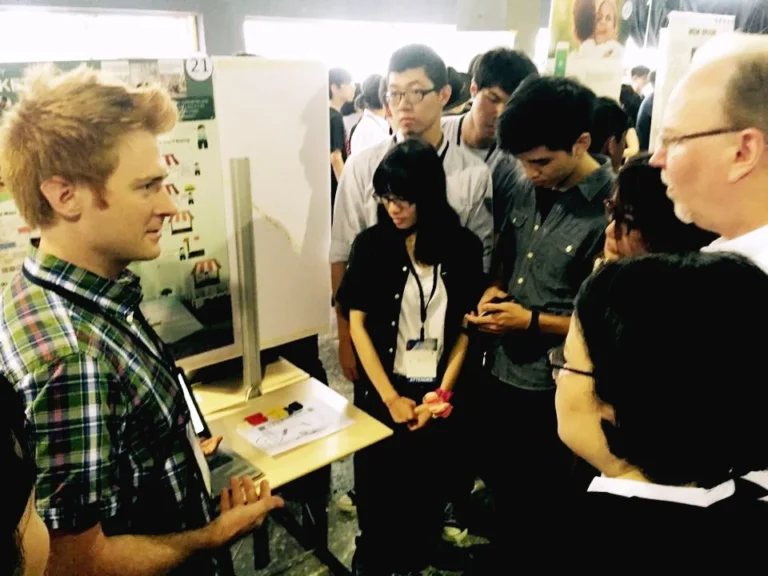

How Can We Help Local Merchants?
Challenge: Improve Social Spaces in Taiwan
Our team of six graduate design students created a community marketplace that supports traditional market experiences with dynamic data.
After developing our concept and presenting it to a panel of MIT scholars and government officials, our team was selected as a finalist amidst a pool of 200 participants across 40 teams.
What is MIT Media Lab?
MIT Media Lab (Cambridge, MA) partners with global city governments and designers to address three primary areas in smart city planning:
Space,
Digital Modeling – approaches urban planning through digital spacial design
Transport – addresses transport needs without relying on fossil fuels or adding to traffic congestion
Definition of Problem
Younger shoppers in Taiwan are abandoning day markets for the appeal of large retailers.
This may cause small, local businesses to suffer.
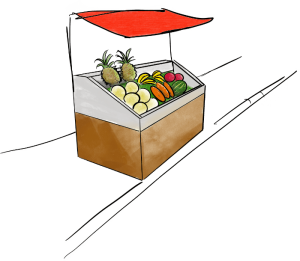



Purpose: Embrace tradition, enhance with tech
Project: Strengthen communities by enhancing traditional markets
- Localize
- Reduce resource waste
- Impart new systems
Setting: Traditional Markets in Taiwan
Challenge: Not convenient to locate items due to crowded and fragmented design
Competitors: Large supermarkets, online retailers
Tech Enhancements:
Connected Market
Proximity Communication
Real Time Marketplace
Competitors
Information was gathered regarding retail habits. To determine whether the hypothesis behind this project warranted further exploration, we engaged in guerrilla user research to understand:
Key areas where younger generations shopped for groceries and household items
Why these areas were appealing to them

Modern Supermarket
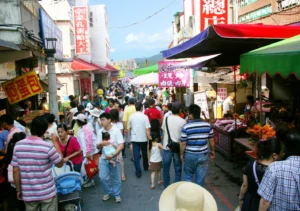
Traditional Day Market
Our team discovered that there were four key factors that influenced their decisions to shop at large grocery stores:
Ease of locating items
Convenient to pay with credit card
Cleanliness
Reliable / trustworthy
Why didn’t they want to shop at traditional markets?
Participants said traditional markets were
Dirty
Loud
Unorganized
Inconvenient
Nonetheless, they agreed that there were positives of shopping at a traditional market.
Unlike big shopping centers, traditional markets offer scores of locally grown and sourced items, many of which are sold by the producers themselves. For this reason, there is a high level of expertise found in traditional markets.
Personas

Sarah, 31, Programmer
Sarah’s a young programmer who wants to pick up a few things for a healthy dinner.
“I don’t have much time. Where’s an easy place to get something?”
Values: Reliability, Speed, Cleanliness

Cindy, 39, Full-time Mom
“I have a lot of things to pick up, so a one-stop-shop is a must!”
“It would be nice to get fresh items, but I don’t always know how to choose them or even where they are.”
Values: Convenient/Proximate, Fresh Items, Expert Advice

Ralph & Christie, 27 & 24, Teachers
“We want to spend Saturday morning out and about, but it seems like we mainly just get brunch.”
“Can’t we find anything else? We’re just not sure where to go!”
Values: New experiences, Fun, Leisure
Brainstorming
Brainstorming & conceptualizing methods were used by our team to sketch out solutions that could leverage positive aspects of both modern and traditional retail while addressing a number of the undesired attributes of traditional markets.
Different stages of ideation brought forth an opportunity for a singular shared space. This enables enforcement of cleanliness standards and waste management.
To support traditional market vendors, areas within this space can be rented for short-term use. This helps invigorate the atmosphere with fresh items and lower investment risk.

Blueprint & Tech
Construction of a Hybrid Market System – Market Touch
This hybrid system is designed to leverage new technology at the discretion of consumers. To be successful, new spaces would need to be accommodating for both those who embrace new technology and for those who don’t.
Technology would serve as a primary facilitator in the new system, Market Touch. Proper use would enable traditional markets to improve upon:
Locating items
Payment convenience
Trust
Vendors and consumers would be connected through a smartphone app. Vendors would transmit information such as:
Products being sold
Location
Pricing
This would be done through app-based proximity awareness.
Consumers would receive this information on their app. Algorithms that compute relevancy through purchase habits, interests, and user-location could then suggest best matches for each consumer.

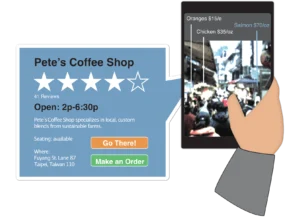
Business Case
Benefit for Vendors
Operating through this digital portal would enable vendors to have unprecedented levels of market data that would enable them to adjust their business based on user trends. Vendors would be able to answer questions such as the following:
What are the demographics of my customers?
How does time of day impact demand on different items in my inventory?
Are there any strategic locations or proximities to other vendors that are advantageous?
What pricing strategy has shown to be most effective?
What is the impact of discounts and promotions?
Where is there new opportunity to serve needs of my customer base?
This information would incentivize vendor participation. Moreover, vendors could also benefit by expanding services, accepting different forms of payment, and building communities of loyal users through the app.
Benefits for Consumers
Consumers would now have the ability to:
Find items on their lists
Pay with a credit card
Read vendor reviews within the app
Mapping and augmented reality would be central parts of the app.
The app would further be bolstered by user reviews, promotions, and list options.
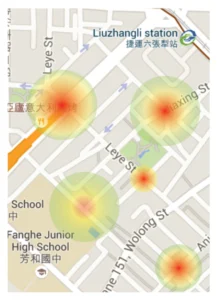
Consumer Activity Heat Map

List Items Displayed on Map
Engagement
Due to dynamic data, consumers could approach their shopping from two different perspectives:
The Efficient Shopper – shops based on necessity and values speed
Build lists on the app from work or home
Reserve / prepay for items on the list
Receive “smart paths” that generate the most efficient path through the market. This would use vendor reservation and inventory data
The Explorer – values the experience and seeks to try new things
Gets suggested paths based on themes and interests, for example, “Health Nut Path” or “Seasonal Favorites.” Completing these paths in order can offer the user promotions. Vendors would need to earn their place on the path by achieving high ratings from previous visitors.
Can connect to step-count goals.
Ability to get involved with a market-enthusiast community
Prototype

Conclusion
This construct of a hybrid market considers the needs of multiple generations, vendors, consumers, and the overall communities that can be served. The idea arises from a desire to support the heritage of Taiwanese culture through positive, modern community practices.
This concept was presented to a panel of industry experts, government officials, and leaders from with the MIT Media Lab. These leaders had an opportunity to meet with our team and gain knowledge of the proposed operation. They inquired about space allocations and were curious about the intricacies of Taiwan’s traditional market culture. After offering suggestions of complimentary opportunities and considerations of logistics, they encouraged us to further pursue this avenue.
Our team was selected as a finalist and had been requested to compete in the final round of the competition the following month. Due to an international presentation scheduling conflict, our team was unable to attend the final round. It was, however, an excellent opportunity to consider the needs of society and to approach them with creative solutions that both preserve and promote culture. This exercise serves as a positive reminder to be cognizant of needs around us and to engage with those directly affected for the purpose of promoting higher qualities of life.
